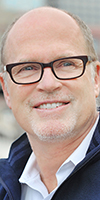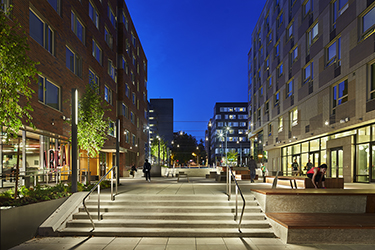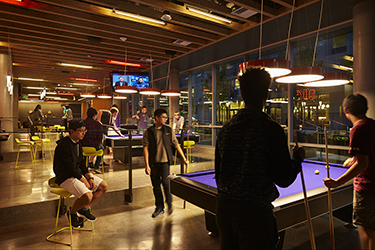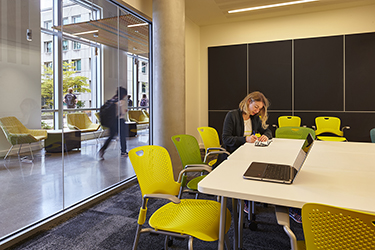|
Subscribe / Renew |
|
|
Contact Us |
|
| ► Subscribe to our Free Weekly Newsletter | |
| home | Welcome, sign in or click here to subscribe. | login |
Construction
| |
 |
November 19, 2015
New UW dorms revive a long-lost urban pathway
Mithun

LaPatra
|
The demographic of students seeking to attend college is continuing to grow — particularly for our state universities — and many of these students are seeking a complete college experience by living on campus.
In addition, today’s students are especially attracted to universities in urban settings. According to a 2014 Nielsen Co. study, Millennials “prefer to live in dense, diverse urban villages where social interaction is just outside their front doors.”
As these trends increase the demand for student housing, universities are expanding beyond campus boundaries and merging into neighborhoods.
The new Terry, Maple and Lander residence halls at the University of Washington’s West Campus exemplify land development patterns at urban universities that are changing from a “buildings in the green” pattern to “buildings in the city.” Located near a new light rail station, bike paths and improved pedestrian connections, these residence halls are contributing to a livable, walkable community and a vital student district.
The original Terry and Lander residence halls were designed as traditional mid-century dormitories, with two high-rise buildings and a dining hall in between. To accommodate this large scale within the urban grid, two streets were closed to create a long block and a 700-foot-long set of buildings without any mid-block break.
The university’s plan was to renovate these buildings. However, as the design and construction team studied the costs of seismic upgrades and modernization, it became apparent that new residence halls could be built for a similar cost and provide more density.
Bert Gregory, Mithun’s project director, summarized the project this way: “The rebuild essentially bought the university a full city block of development capacity in Seattle a few blocks from future light rail, added capacity for 600 more students with quality amenity spaces, while providing great public spaces and new connectivity to the city.”
A connected campus
Rebuilding also opened tremendous opportunities to realize elements of the university’s 2001 master plan.
Where the closed streets created a barrier, “the master plan’s goal was to integrate the neighborhood with the campus and provide safe, direct access connecting the residence halls and providing access to Portage Bay at the south,” said Mithun Principal Emeritus Lee Copeland, who designed the plan while at his previous firm Weinstein Copeland.
The plan restored the orthogonal grid structure of the area, and enhanced Campus Parkway with pedestrian and bicycle circulation through the neighborhood and to the central UW campus.
“To a great extent the goals of the master plan are being realized,” Copeland said.
Now, 12th Avenue Northeast no longer dead-ends at a building. Instead, a new pedestrian street and plaza increases connectivity for bicyclists and pedestrians, and provides spaces with benches and tables for socializing.
Living spaces
The new West Campus developments also support the university’s mission of providing a comprehensive approach to student life beyond the classroom. Students living in residence halls are on their own for the first time, and the spaces at Lander, Terry and Maple halls create places for students to learn, live healthy, eat healthy and connect socially.
Numerous spaces, indoors and out, foster collaboration and shared learning as students gather in small groups to work on projects or just hang out. Places for students to interact are created through programming, as well as locations of lounges, stairways and lobbies.
For example, at Lander Hall, students’ rooms wrap an interior courtyard that accommodates games, exercise or relaxing and studying. This private, extensively landscaped outdoor space fosters more interaction and a sense of a Lander community.
The dining facility for the area’s nearly 6,000 students is located at the heart of West Campus in Lander Hall, where students are encouraged to learn about healthy food. Lined with glass walls to inspire student engagement, an innovative chef’s table with theater-style seating accommodates classes in nutrition and cooking, and doubles as a space for relaxed dining or meeting friends. This mixing of spaces is another trend among universities, maximizing their available square footage while providing amenities that students love.
Building community is the primary goal of these LEED gold buildings, as freshmen begin to live on their own in this transformational time. Spaces are created for friends to get together and play music in the “music lab,” cook a meal in the group kitchen, celebrate birthdays, or play billiards and pingpong in the game center.
Maple Hall’s “great room,” at the heart of the building and filled with daylight, is a welcome place for all types of activities. This flexible, two-story space can serve as a lecture hall then quickly become a study lounge, and later convert for movie night.
Study rooms
Much of today’s curriculum is taught outside the classroom through group study. Now this activity has come to the residence hall, with a plethora of study rooms available on all floors.
Lander, Terry and Maple halls reflect these blurred lines between academic and social spaces with flexible classrooms and spaces for large groups, small groups or team projects. At Lander Hall, a help desk is staffed with advisors for any freshman question, supporting people who have never lived on their own.
Blending indoor spaces with the outdoors, the sidewalks and plazas also offer a series of communal spaces for students to recreate, study, relax, collaborate and dine. These areas become the social mixing areas for students through a series of walkable plazas and street-fronts that further blend the campus into its unique student-focused urban neighborhood.
The design strategies behind Terry, Maple and Lander halls and the West Campus master plan help the university meet a number of objectives. They create housing and amenities that today’s students want amid an increasingly competitive higher-education landscape, they accommodate growth for universities within a tight urban footprint, and they help blend the campus edges with city neighborhoods.
The daily pulse of activity around West Campus provides the real evidence of the design in action — and the shared benefits of integrating a university with its surroundings.
Bill LaPatra is a partner at Mithun, an integrated design firm with offices in Seattle and San Francisco.
Other Stories:
- No detail is too small for UW nanoengineering lab
- How crews used BIM to cope with unwelcome surprises at Denny Hall
- Classroom of the future takes shape at WSU— and it's round
- UW, WSU find ways to do more with less
- WSU’s Paccar building houses 5 R&D labs
- WSU’s wine center aims to train next generation of winemakers
- UW: Top 10 capital projects
- WSU: Top 10 capital projects





